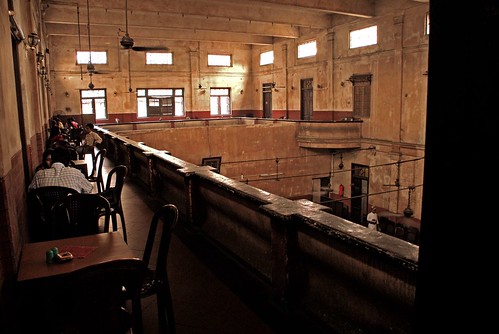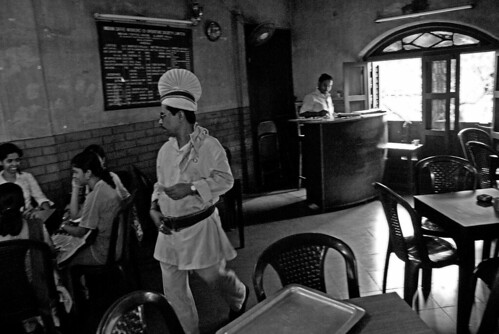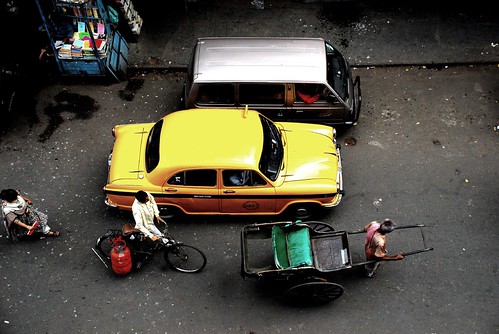
In the beginning, before Café Coffee Day, Cafe Barista and their likes there stood Calcutta Coffee House, ''a village in the center of the metropolis, steaming with gossip, curiosity, political intrigue and slander.”
Situated in the heart of Calcutta, opposite the Presidency College, commissioned in 1942 by The Indian Coffee Workers' Co-operative Society, the coffee house quickly developed on the lines of a student Literaten Kaffeehaus. Satyajit Ray would dream up films here, while many a writer consumed coffee beneath its the vaulted arches. Noise, gossip and cup-carrying waiters seethed between the writers and their subjects.
A Monument to Calcutta's Glory

Here under the high whistling ceiling fans and in the environs of these fading mildew covered brown walls sat tragic young writers with puff-pastry egos; the air was thick with philosophical rantings as dense as the number on their glasses. More than any other coffeehouse, perhaps, the Calcutta Coffee House exemplified this Antelle attitude, a monument to the glory of Calcutta and its uplifting elixir, caffeine and the rich conversation it spewed.
The coffee house has been impervious to change since its inception and has slowly trotted along for more than 50 years of its existence. Albert Hall, as the place was known before the present sobriquet was bestowed by the Central Government, was already a favourite with Rabindranath Tagore and Subhash Chandra Bose and could boast of a legacy of swadeshi meetings. A place that had carved out a niche for itself as the most popular adda was thus the easiest choice for the promotion of coffee in a city till then an excellent market for tea.
Although its presence once burned like a supernova, the coffee house has been rocked by numerous upheavals that have threatened to close it down and close it did on at least one occasion only to reopen after much uproar the Calcuttans created, at the loss of their most beloved adda.
Smoke from an entire barrage of cigarettes spirals up to the ceiling as people drink their coffee with an accompanying glass of cold water, reading newspapers while eating samosas or Chicken Afghani (only twenty-three rupees). Elderly turbaned waiters in faded white uniforms drift from table to table. Everyone knows about Calcutta’s love for talk especially about exalted topics from Dosteovsky to the vagaries of Indian cricket. It usually involves some amount of talk about cricket, politics, football, food and always with a footnote about the songs of Tagore. The Coffee House permeates this talk, a bright hum insulated by its high vaulted ceilings from the noise of the street outside.


'All the literary giants came here,'' said Aparna Sengupta, who was drinking coffee and pointing to the picture of Tagore on the wall. ''It's a special Calcutta place.'' She was seated with a group of six girls probably her classmates who were attempting to learn German from a old copy of a textbook. ''I like the atmosphere,'' said 23-year-old Amal Basu, who was alternately reading a novel and the newspaper-The Statesman. “But they still need to stop this place from falling apart,”he said, pointing to the walls.
Mr. Basu, a regular, was smoking Goldflake cigarettes. ''The coffee is terrible here,'' he said, ''but atleast I can afford it.''

Indeed, there is a general feeling that the days of intellectual revelry have passed it by for a blander experience. Those days have definitely gone but the Calcutta Coffee House has desperately held onto the atmosphere of an era gone by: the dark-brown walls; the stark wooden chairs and tables; white porcelain and steel cutlery.
“There are too many shirts and ties in the crowd”, complains Mr Das, a wizened patron, musing on the changes, while eating his bread-butter. ''I doubt it will again become a cafe for literary people or philosophers,'' he said. ''These kind of people do not exist anymore. They are working mainly in IT.''

Unknown
Hi, We are templateify, we create best and free blogger templates for you all i hope you will like this blogify template we have put lot of effort on this template, Cheers, Follow us on: Facebook & Twitter